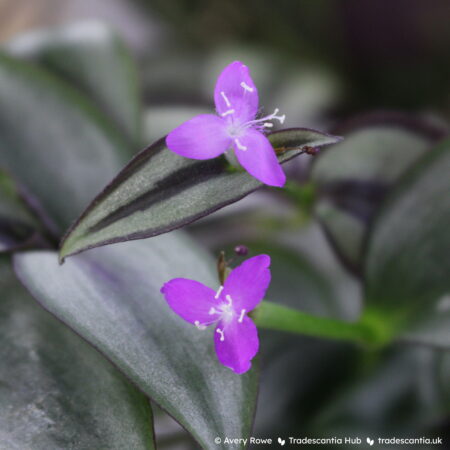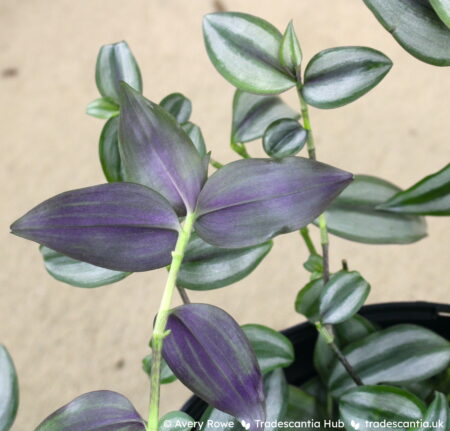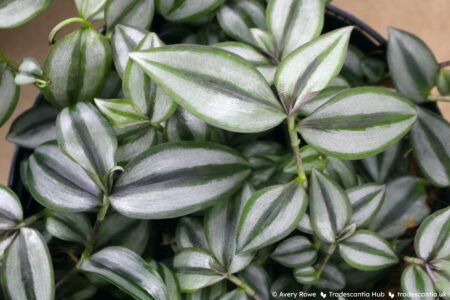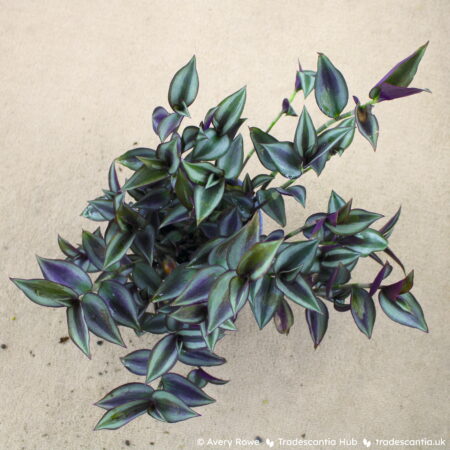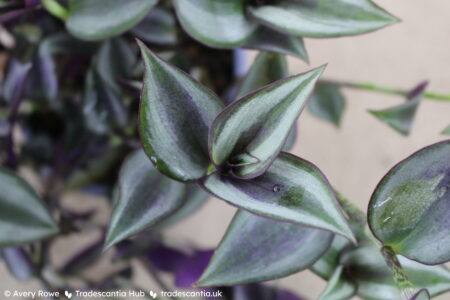Details
| Full name | Tradescantia zebrina Superba Group. |
| Name status | Accepted, the valid name for a cultivar group. Established by Teas (1872, p. 12). First identifiably described by Cascade Nursery Company (1874, p. 34). Because it was published before 1959, the Latin name can be accepted (Brickell et al., 2016, Art. 21.11). Also known as:
None of the established names is widely used today, so Superba is now accepted because it is the least ambiguous and has not been used for any other cultivar. |
| Origins | Unknown. |
| Classification | Originally treated as a single cultivar, the group is now known to contain multiple clones with identical foliage and subtly different flower colours. The species Tradescantia zebrina is sometimes labelled with its botanical synonyms Tradescantia pendula, Zebrina pendula and Cyanotis zebrina. |
| Included cultivars | There are probably 2-5 distinct clones in circulation. Most are not clearly distinguished from one another, so the exact number and identity of unique cultivars in the group is unknown. |
Description
Represented by a herbarium specimen (“Tradescantia zebrina ‘Superba'”, 2022).
Described with reference to the RHS Colour Chart (6th Edition: 2019 reprint).
| Species | Tradescantia zebrina. |
| Growth habit | Stems initially grow upright but soon start to sprawl and trail out of any container. |
| Foliage | Stems are 2-5mm wide, with internodes 2-6cm long. The colour ranges from strong yellow green (144A) to greyish purple (N77A) in between. Stems are dotted with lighter green freckles and completely hairless. Leaves are slightly asymmetrical pointed ovals, 4-8cm long and 2.5-4cm wide. There are a few hairs at the top of the sheath, and sometimes scattered over the leaf surfaces. Each half of the leaf has a stripe running its length, closer to the edge of the leaf, and taking up 50-70% of its total width. In moderate light, the base colour of newly-matured leaves is greyish olive green (NN137A) to moderate olive green (137A). In intense light the base colour becomes dark greyish purple (N92A) or dark red (187A). The stripes are light grey (191C) to greenish grey (N189C), extremely shimmery and metallic, and become speckled with dark purple (79A) in intense light. Leaf undersides range from greyish purple (N187B) in moderate light, to dark purple (79A) in intense light, sometimes with moderate yellow green (138B) veins. Sheaths are moderate yellow green (138C). |
| Flowers | Flowers are about 15mm across. Petals range from strong purple (N80A) to light reddish purple (N75A) depending on the clone. The anthers are white, and stamens are white with pink or purple filaments. |
References
Teas, E. Y. (1872). Descriptive Catalogue of New, Rare and Beautiful Plants, Roses, Dahlias, Geraniums, Greenhouse and Bedding Plants, Flower and Vegetable Seeds. Internet Archive link.
Cascade Nursery Company. (1874). Catalogue of New and Rare Plants. Internet Archive link.
Brickell, C. D., Alexander, C., Cubey, J. J., David, J. C., Hoffman, M. H. A., Leslie, A. C., Malécot, V., Jin, X. (2016). International Code of Nomenclature for Cultivated Plants. PDF link.
Tradescantia zebrina ‘Superba’. (2022). [Herbarium specimen, barcode WSY0168494]. RHS Wisley Herbarium.

